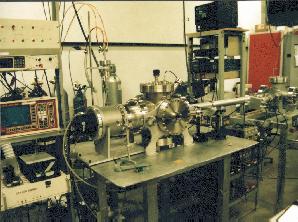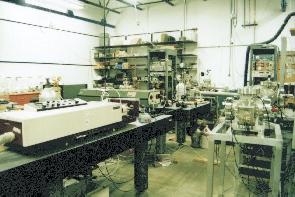

Study of state select electron captures from neutral atoms
by multiply charged ions from solid elements (such as molybdenum, iron,
silicon, and tungsten) and gaseous elements (such as oxygen and nitrogen).
This research project addresses the role of multiply charged ions in both
fusion and astrophysical plasmas.
Joint project with Dr. W. H. Parkinson of the Harvard-Smithsonian Center for Astrophysics to study the atomic structure of multiply charged atomic ions that are used in the diagnostics of fusion and astrophysical plasmas. This study includes the precise measurement of the radiative lifetime of the metastable state of atomic ions.
Study of the properties of laser-produced plasmas from solid targets as well as gaseous targets. The results of this study will help scientist to assess the use of laser-produced plasmas as an ion source for ion storage facilities, ion beam facilities, and thin film deposition as well as a high density broad-band photon source for spectroscopy and a pump source for short wave length lasers.
Development of a laser-based plasma diagnostic technique to determine the basic properties of plasmas (electron temperature and density) and their chemical compositions.
Development of a laser-based ultra-micro ultra-trace elemental detection technique with a sampling size less than a micro-gram with at least one part per trillion in sensitivity.
Study of UV and the soft x-ray emission of high temperature laser-induced plasmas. These plasmas can be used for soft x-ray lasing medium.
Study of ceramic thin film barrier enhancement on borosilicate glass for nuclear waste storage.


This facility will be used to measure the charge exchange cross-sections of highly stripped oxygen and carbon solar wind ions and water and carbon monoxide molecules in a comet atmosphere. These measurements can help to resolve the riddle of x-ray emissions in comets.

These facilities consist of several pulsed lasers that include
two high-power Nd:YAG lasers, three excimer lasers, one ruby laser, two
narrow-band dye laser oscillators, and an amplifier system. This facility
is capable of producing a wide range of atomic and molecular ions and neutrals
from both solid and gaseous targets for the ion storage facility. This
facility is being used by Roberto Razo, a graduate student, to study the
population
ratio of metastable and ground states of ions in laser-induced plasmas.
This population ratio can provide information on the temperature of the
plasma. These facilities can also be used to carry out nonintrusive,
remote diagnosis of a variety of plasmas.


"Dissociative Charge Transfer Reactions of Ground State He+ with
N2 and CH4 at Electron-Volt Energies," Z. Fang, D. Chen, and V.H.S. Kwong,
(Submitted to Phys. Rev. A., 2000).
"Dissociative Charge Transfer Between Ground State He+ and CO at Electron-Volt Energies, " V.H.S. Kwong, D. Chen, and Z. Fang, Astrophysics Journal (accepted for publication, June 2000).
"Charge Transfer Between Si4+ ion and Helium at Electron-Volt Energies," Z. Fang and V.H.S. Kwong, Phys. Rev. A59, 342, 1999.
"Reflection Time-of-Flight Mass Spectometer for Charge-Transfer Cross Section Measurements," Jiebing Wang and V.H.S. Kwong, Rev. Sci. Insturm, 68, 1997.
"Charge Transfer between Ground-State Si3+ and He at Electron-Volt Energies," Z. Fang and V.H.S. Kwong, Ap.J., 483, 527, 1997.
"Charge Transfer between Ground-State N2+ and H2, N2 and CO at Electron-volt Energies," Z. Fang and V.H.S. Kwong, Phys. Rev. A55, 440, 1997.
"Measurement of Charge Transfer Rate Coefficients between Ground- state N2+ Ion and He at Electron-volt Energies," Z. Fang and V.H.S. Kwong, Ap.J., 474, 529, 1997.
"Production and Storage of Ground State O2+ and Charge Transfer of O2+ with Neutrals at eV Energies," V.H.S. Kwong and Z. Fang, in "Non- neutral plasma physics II," AIP Conference Proceedings 331, Ed. Fajans and Dubin, AIP Press, 1995, P108-112.
"Measurement of Charge Transfer Rate Coefficient between O2+ Ions and He, H2, N2, and CO at Electronvolt Energy," Z. Fang and V.H.S. Kwong, Phys. Rev. A51, 1321, 1995.
"Production and Storage of O2+ Ions from Ion Oxide Targets," Z. Fang and V.H.S. Kwong, Rev. Sci. Instru. 65, 2143, 1994.
"Charge Transfer between O2+ Ion and Helium at Electronvolt Energy," V.H.S. Kwong and Z. Fang, Phys. Rev. Lett. 71, 4127, 1993.
"Radiative Lifetimes of the 2s2p2(4P) Metastable Levels of NIII," Z. Fang, V.H.S. Kwong and W.H. Parkinson, Astrophysical Journal Letter, 413, L141, 1993.
"Measurement of Radiative-decay Rates of the 2s22p(2Po)-2s2p2(4P) Intersystem Transition of CII," Z. Fang, V.H.S. Kwong, J. Wang, and W.H. Parkinson, Phys. Rev. A 48, 1114, 1993.
"Measurement of the Transition Probability of CIII 190.9 nm Intersystem Line," V.H.S. Kwong, Z.Fang, T.T. Gibbons, W.H. Parkinson, P.L. Smith, Astrophysical Journal, 411, 431, 1993.
"Measurement of Thermal Energy Charge Transfer Rate Coefficient of Mo6+ and Argon," V.H.S. Kwong, Z. Fang, Y. Jiang, T.T. Gibbons and L.D. Gardner, Physical Review A46, 201, 1992.
"Experimental Apparatus for Production, Cooling and Storing Multiply Charged Ions for Charge Transfer Measurements," V.H.S. Kwong, T.T. Gibbons, Z. Fang, J.Jiang, H. Knocke, Y. Jiang, B. Rugar,, S. Huang, E. Braganza, W. Clark and L.D. Gardner, Rev. Sci. Instrum. 61, 1931, 1990.
"Cooling and Trapping of Laser Induced Multiply Charged Ions of Molybdenum," V.H.S. Kwong, Journal de Physique, 50, C1-413, 1989.
"Production and Storage of Low-Energy Highly Charged Ions by Laser Ablation and Ion Trap," Phys. Rev. A39, 4451, 1989.
"Measurement of Transition Probabilities for Spin-Changing Lines of Atomic Ions Used in Diagnostic of Astrophysical Plasmas," P.L. Smith, B.C. Johnson, H.S. Kwong, W.H. Parkinson and R.D. Knight, Phys. Scripta, T8, 88-94, 1984.
"Measurement of the A-value of the 3s2 1S0 - 3s3p 3Po1 Intersystem Transition in AlI at 2670 A: A Progress Report, B.C. Johnson,H.S.Kwong, Proceedings of the 8th International Colloquium on Ultraviolet and X- ray Spectroscopy of Astrophysical and Laboratory Plasmas, 1984.
"Transition Probability of SiIII 189.2 nm Intersystem Line," V.H.S. Kwong, B.C. Johnson, P.L. Smith, and W.H. Parkinson, Phys. Rev. A27, 3040, 1983.
"Laser-Excitation Technique for the Measurement of Absolute Transition Probabilities of Weak Atomic Lines," H.S. Kwong, P.L. Smith, and W.H. Parkinson, Phys. Rev. A25, 2629, 1982.
"Lifetimes Measurements of Atoms in Compounds Embedded in Matrices Using Laser Selective Excitation and Ablation Dynamics," H.S. Kwong, R.M. Measures, Appl. Opt., 19, 1025-27, 1980.
"Trace Element Laser Microanalyser with Freedom from Chemical Matrix Effect," H.S. Kwong, R.M. Measures, Anal. Chem., 51, 428-32, 1979.
"Trace (element) Analyser Based on Laser Ablation and Selective Excited Radiation," R.M. Measures, V H.S.Kwong, Appl. Opt.,18, 281-86, 1979.
"TABLASER - A New Concept for Trace Element Laser Microprobe," R.M. Measures and H.S. Kwong, Proceedings of the International Conference on Lasers 78, ed. V.J. Corcorn, STS Press, 88, 1979.
"Atomic Lifetimes Measurements Obtained by the Use of Laser Ablation and Selective Excitation Spectroscopy," R.M. Measures, N. Drewell and H.S. Kwong, Phys. Rev. A16, 1093-97, 1977.